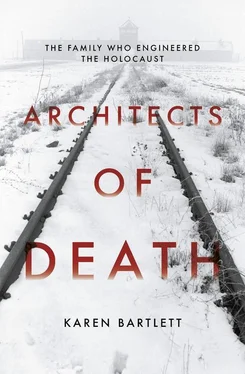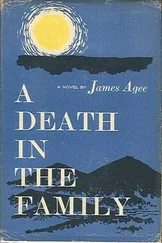‘I was and am a German, who is loyal to the German government and its laws,’ Schultze replies. ‘That’s why I considered those who had fought against this government and its measures, including those in the German-occupied territories, to be criminals. They were condemned in line with German laws, because they had murdered representatives of German authorities and the German military.’ Although he was never a member of the Nazi Party, Schultze adds that he ‘believed it to be my duty to respect and obey the laws of my land’.
The interrogator concludes by stating that Schultze had already confessed in 1946 to his role in building the gas chambers and crematoria, and he urges Schultze to ‘tell us what led you to pursue this criminal path?’ At this point Schultze diverges from the strict explanation of ‘wartime duty’ that his Topf colleagues have so far adhered to.
I did not get involved in the building and equipping of crematoria in concentration camps and the gas chambers in Auschwitz on my own initiative, but did so on the orders of the boss of Topf and Sons, where I was employed. If I had refused to carry out this work, I could have been dismissed as a saboteur and been subjected to reprisals. It was out of fear of this that I never asked the company boss Ludwig Topf to refrain from using me for these projects. [123] Karl Schultze interrogation report, Landesarchiv Thüringen - Hauptstaatsarchiv Weimar.
This is the first time a Topf defendant has claimed that they carried out their work for the simple reason that they were afraid not to. If true, it might be a plausible justification – but all of the evidence demonstrates that this wasn’t the case. At no point did any senior member of staff at Topf and Sons, or either of the Topf brothers, appear to be afraid of the SS. To the contrary, they often expressed frustration and annoyance and were tardy when completing work if it suited them. As the previous chapter outlines, Topf and Sons would occasionally turn down SS commissions if the company was too overstretched to fulfil them – without any fear of reprisals.
When interrogated Kurt Prüfer, the instigator and innovator for all of Topf and Sons’ work with the SS, attempts a similar blend of detailed fact and obfuscation, confusion over dates and lies about knowledge and motive.
Prüfer begins by stating:
Until 1943, I didn’t know anything about the real purpose of the crematoria in the concentration camps. I only found that out when I visited Auschwitz. Until then, the people from the SS construction management units who led the discussions with the Topf company had always said that the concentration camp crematoria were for the cremation of corpses of prisoners who had died a natural death as a result of epidemics.
I only found out about the existence of gas chambers at Auschwitz when I visited the camp in 1943. Until then I knew nothing about either their existence or their purpose.
I would also like to emphasise that the Topf company never built any gas chambers in the concentration camps. I only know that the Topf company fitted two ventilation systems for the gas chambers in the Auschwitz concentration camp.
The interrogator asks Prüfer what he specifically discovered about the nature of the gas chambers and crematoria during his visit to Auschwitz in 1943. Prüfer replies:
I discovered that the mass murder of people, including women, children and the elderly, was taking place in the camp. Hitler’s people were bringing them to Auschwitz in transport trains from German-occupied European countries. The prisoners brought to Auschwitz were sent to the gas chamber by the SS, where they were killed. Their bodies were then incinerated in the crematoria and special fire pits.
Asked if this implies that he was aware the crematoria he was building were for the disposal of the bodies of innocent people, Prüfer replies: ‘Yes, I knew that.’ Why, then, the interrogator queries, did he continue to work on their construction? This time Prüfer points the finger of blame at Ludwig Topf:
After I’d discovered the real purpose of the crematoria in the Auschwitz concentration camp, I considered refusing any further involvement in their construction, and I said this to the company boss, Ludwig Topf.
Ludwig Topf replied that the construction of the concentration camp cremation furnaces was a commission from the Reich HQ of the SS, and that if I refused to work on them, I could be arrested and sent to a concentration camp myself for sabotage.
Prüfer adds that he feared losing his job and suffering reprisals from the Nazis. After a disagreement over the date upon which he became aware of the true nature of the gas chambers and crematoria, Prüfer explains that the conditions were first described to him on a visit to Auschwitz in 1942.
Claiming to have come upon this revelation ‘by chance’, Prüfer says:
In early 1942, the Auschwitz SS construction management unit asked me to go to the camp to assess a design for a new Crematorium In the Auschwitz section of the camp and to view the proposed site for it.
I viewed the proposed site with one of the SS men. As we drove past Crematorium I, I saw through the half-opened door a room with human corpses lying on the floor in various poses; there were more than ten of them. When I approached this room, someone quickly slammed the door shut from inside. Since I didn’t know what this room in Crematorium I was used for, I asked the SS man about it. He said that there was a gas chamber in there, where prisoners were gassed to death.
In answer to my next question about how the gas chamber worked, the SS man answered evasively, claiming that he didn’t know anything about it, before telling me that he knew there were gas chambers in the city of Lodz, in which the SS had carried out gassings using vehicle exhaust fumes. At some point they had accelerated this process through the use of some kind of gas. The SS man said that the use of gas in the Lodz gas chambers had reduced the killing time from 10–15 minutes to 1–2 minutes.
The SS man told me that the killings in the Lodz gas chamber went as follows: the prisoners were forced into the gas chambers, the doors were hermetically sealed, and then gas balloons were thrown in through special openings. On the basis of this description, I concluded that prisoners in the gas chamber that the SS had built in Crematorium I at Auschwitz were being killed in the same way.
As the interrogation progresses, Prüfer admits that while he was not responsible for the installation of the ventilation systems, he did assist the SS in their attempts to source gas analysers that were used to measure the cyanide level in the chamber – something far beyond his remit as a furnace engineer.
When Von Bischoff came to me with this request, he explained that hydrogen cyanide fumes still remained in the gas chambers after the prisoners had been gassed, even after ventilation, leading to the poisoning of people working there. Von Bischoff therefore asked me to find out which companies were producing gas analysers, with a view to using them to measure the concentration of the hydrogen cyanide fumes in the gas chambers and thereby avoid endangering the workers.
Prüfer adds that, on this occasion, he was unable to help the SS, as he had struggled to find companies who produced gas analysers. The interrogator then asks if Prüfer himself was involved in testing the crematoria on site. Prüfer responds:
No. That was done by fitters from the company who were carrying out building and assembly work in these crematoria under my direction. On my visits to Auschwitz I observed and checked the functioning of the cremation furnaces in operation. During this checking, bodies of prisoners killed in the gas chambers by the SS were incinerated in my presence. [124] Kurt Prüfer interrogation report, Landesarchiv Thüringen - Hauptstaatsarchiv Weimar.
Читать дальше












